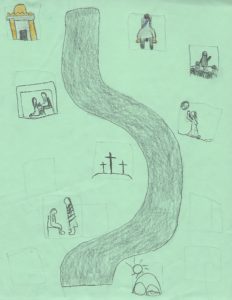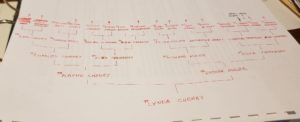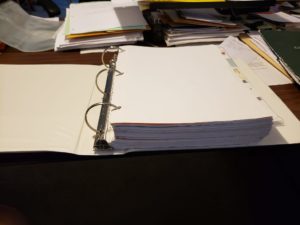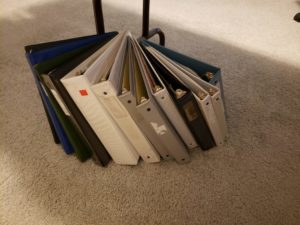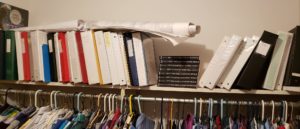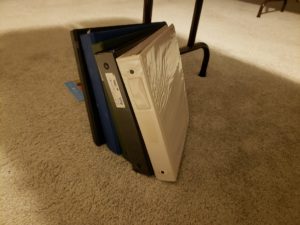
With the after-effects of the stoke having slowed my typing, I’ve now for just under a week been back to writing. Typing is still slow, but improving. It’s good to be back in the saddle. That doesn’t mean just on writing, but also on two special projects.
One of those is continuing to scan my genealogy research papers and safe them electronically. I’ve blogged about this before. More than half of my notebooks are culled and the contents either digitized or discarded. But all the easy parts are done. Most of what’s left are for the four family lines I spent the most time on in my research. I’m having to go through them more carefully. Some of the papers, mainly original documents I obtained, I’ll still save after scanning.
I worked on this last Friday and Saturday. I found that my electronic file saving system works, but also that I had a lot more folders to add. Saturday, beginning work on a new notebook, I realized I had in it mainly ancestors for whom I had no electronic folders. Since my folders are alphabetized first on Ahnentafel number, and also indicate the generation of the ancestor, it takes some time to get the folders properly created. Most of my time Saturday was spent on folder creation and organization, but did get some papers scanned, saved, and discarded. I also managed to scoop up about a half-dozen sheets that needed filing elsewhere (i.e. not in a genealogy notebook that’s a keeper) and got them filed. It’s those stragglers that are always a hindrance to keeping my work area clean.
The other special project is transcribing the letters from our years in Saudi Arabia, 1981-1983. I did this for the Kuwait years, 1988-1990 (and some after that) and put them in a book for family members. I blogged about that several times.
Now I’m on the Saudi letters. It’s quite different. No displacement due to war; the kids were little so no letters by them; no phone so we wrote more letters; but no computer so they were all handwritten.
I collected the letters into one bin and collated them some time ago. In early January (I think it was), I began transcribing 1981 letters. They were all done except for the two Christmas letters we sent that year, and one or two more, when I had my stroke. So, before I started back on my writing work, I knuckled down and, with my right hand still typing-impaired, got them done about a week and a half ago.
The total count for the seven months in 1981 was 53 unique letters. There were other items in the bind, but mainly empty envelopes and duplicate letters, where we photocopied a letter and sent it to several people, usually with a personal note attached.
I pulled out the box of letters for 1982 in preparation for the next phase of this task. I counted 75 letters, I think it was (some of them postcards), and some possibly duplicates. A few envelopes felt like they might have been empty. The stack for 1983 looks about the same size.
I don’t have a deadline for either of these projects. The end of 2024 is sort of a loose goal, and, I think, very doable so long as I don’t get lazy. And so long as my regular writing and home upkeep doesn’t overpower my time.
